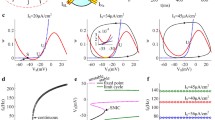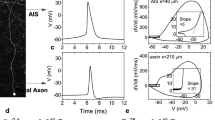Abstract
Somatic action potentials (AP) of cortical pyramidal neurons have characteristically high onset-rapidness. The onset of the AP waveform is an indirect measure for the ability of a neuron to respond to temporally fast-changing stimuli. Theoretical studies on the pyramidal neuron response usually involves a canonical Hodgkin-Huxley (HH) type ion channel gating model, which assumes statistically independent gating of each individual channel. However, cooperative activity of ion channels are observed for various cell types, meaning that the activity (e.g. opening) of one channel triggers the activity (e.g. opening) of a certain fraction of its neighbors and hence, these groups of channels behave as a unit. In this study, we describe a multi-compartmental conductance-based model with cooperatively gating voltage-gated Na channels in the axon initial segment. Our model successfully reproduced the somatic sharp AP onsets of cortical pyramidal neurons. The onset latencies from the initiation site to the soma and the conduction velocities were also in agreement with the previous experimental studies.










Similar content being viewed by others
References
Almers, W., & Stirling, C. (1984). Distribution of transport proteins over animal cell membranes. The Journal of Membrane Biology, 77(3), 169–186.
Angelides, K., Elmer, L., Loftus, D., & Elson, E. (1988). Distribution and lateral mobility of voltage-dependent sodium channels in neurons. The Journal of Cell Biology, 106(6), 1911–1925.
Baranauskas, G., & Martina, M. (2006). Sodium currents activate without a hodgkin-and-huxley-type delay in central mammalian neurons. The Journal of Neuroscience, 26, 671–684.
Baranauskas, G., Mukovskiy, A., Wolf, F., & Volgushev, M. (2010). The determinants of the onset dynamics of action potentials in a computational model. Neuroscience, 167(4), 1070–1090.
Bekkers, J., & Hauser, M. (2007). Targeted dendrotomy reveals active and passive contributions of the dendritic tree to synaptic integration and neuronal output. Proc Nal Acad Sci USA, 104, 11, 447–11, 452.
Boucsein, C., Tetzlaff, T., Meier, R., Aertsen, A., & Naundorf, B. (2009). Dynamical response properties of neocortical neuron ensembles: multiplicative versus additive noise. The Journal of Neuroscience, 29(4), 1006–1010.
Brette, R. (2013). Sharpness of spike initiation in neurons explained by compartmentalization. Plos Comput Biol, 9(12), e1003, 338.
Colbert, C., & Johnston, D. (1996). Axonal action-potential initiation and Na+ channel densities in the soma and axon initial segment of subicular pyramidal neurons. The Journal of Neuroscience, 16(21), 6676–6686.
Colbert, C., & Pan, E. (2002). Ion channel properties underlying axonal action potential initiation in pyramidal neurons. Nature Neuroscience, 5, 533–538.
Dekker, J., & Yellen, G. (2006). Cooperative gating between single hcn pacemaker channels. The Journal of General Physiology, 128(5), 561–567.
Dixon, R.E., Yuan, C., Cheng, E.P., NAvedo, M.F., & Santana, L.F. (2012). Ca2+ signaling amplification by oligomerization of l-type cav1.2 channels. Proc Nal Acad Sci, 109(5), 1749–1754.
Doyle, D., Cabral, J.M., Pfuetzner, R., Kuo, A., Gulbis, J., Cohen, S., Chait, B., & MacKinnon, R. (1998). The structure of the potassium channel: molecular basis of k+ conduction and selectivity. Science, 280 (5360), 69–77.
Dzhashiashvili, Y., Zhang, Y., Galinska, J., Lam, I., Grumet, M., & Salzer, J. (2007). Nodes of ranvier and axon initial segments are ankyrin-g-dependent domans that assemble by distinct mechanisms. The Journal of Cell Biology, 177, 857–870.
Ermentrout, B., Pascal, M., & Gutkin, B. (2001). The effects of spike frequency adaptation and negative feedback on the synchronization of neural oscillators. Neural Computation, 13, 1285–1310.
Eyal, G., Mansvelder, H., de Kock C., & Segev, I. (2014). Dendrites impact the encoding capabilities of the axon. The Journal of Neuroscience, 34(24), 8063–8071.
Fleidervish, I., Lasser-Ross, N., Gutnick, M., & Ross, W. (2010). Na+ imaging reveals little difference in action potential-evoked Na+ influx between axon and soma. Nature Neuroscience, 13(7), 852–860.
Fourcaud-Trocme, N., & Brunel, N. (2005). Dynamics of the instantaneous firing rate in response to changes in input statistics. Journal of Computational Neuroscience, 18(3), 311–321.
Fourcaud-Trocme, N., Hansel, D., van Vreeswijk, C., & Brunel, N. (2003). How spike generation mechanisms determine the neuronal response to fluctuating inputs. The Journal of Neuroscience, 23(37), 11, 628–11, 640.
Gabelli, S.B., Boto, A., Kuhns, V.H., Bianchet, M.A., Farinelli, F., Aripala, S., Yoder, J., Jakoncic, J., Tomaselli, G.F., & Amzel, L.M. (2014). Regulation of the nav1.5 cytoplasmic domain by calmodulin. Nature Communications, 5, 5126.
Grubb, M., & Burrone, J. (2010). Building and maintaining the axon initial segment. Current Opinion in Neurobiology, 20(4), 481–488.
Häusser, M., Stuart, G., Racca, C., & Sakmann, B. (1995). Axonal initiation and active dendritic propagation of action potentials in substantia nigra neurons. Neuron, 15(3), 637–647.
Hay, E., Schrmann, F., Markram, H., & Segev, I. (2013). Preserving axosomatic spiking features despite diverse dendritic morphology. Journal of Neurophysiology, 109, 2972–2981.
Hodgkin, A.L., & Huxley, A.F. (1952). A quantitative description of membrane current and its application to conduction and excitation in nerve. The Journal of Physiology, 117, 500–544.
Hu, W., Tian, C., Li, T., Yang, M., Hou, H., & Shu, Y. (2009). Distinct contributions of na(v)1.6 and na(v)1.2 in action potential initiation and backpropagation. Nature Neuroscience, 12(8), 996– 1002.
Huang, H. (2006). Molecular mechanism of antimicrobial peptides: the origin of cooperativity. Biochimica et Biophysica Acta, 1758(9), 1292–1302.
Huang, M., Volgushev, M., & Wolf, F. (2012). A small fraction of strongly cooperative sodium channels boosts neuronal encoding of high frequencies. PLoS One, 7, e37629.
Kole, M., & Stuart, G. (2008). Action potential generation requires a high sodium channel density in the axon initial segment. Nature Neuroscience, 11(11), 1253–1255.
Kole, M., Ilschner, S., Kampa, B., Williams, S., Ruben, P., & Stuart, G. (2008). Is action potential threshold lowest in the axon? Nature Neuroscience, 11, 178–186.
Köndgen, H., Geisler, C., Fusi, S., Wang, X., Lüscher, H., & Giugliano, M. (2008). The dynamical response properties of neocortical neurons to temproally modulated noisy inputs in vitro. Cerebral Cortex, 18(9), 2086–2097.
Mainen, Z., Joerges, J., Huguenard, J., & Sejnowski, T.A. (1995). model of spike initiation in neocortical pyramidal neurons. Neuron, 15(6), 1427–1439.
Marx, S., Ondrias, K., & Marks, A. (1998). Coupled gating between individual skeletal muscle ca2+ release channels (ryanodine receptors). Science, 281(5378), 818–821.
Marx, S. O., Gaburjakova, J., Gaburjakova, M., Henrikson, C., Ondrias, K., & Marks, A. R. (2001). Coupled gating between cardiac calcium release channels (ryanodine receptors). Circulation Research, 88, 1151–1158.
McCormick, D., Shu, Y., & Yu, Y (2007). Neurophysiology: Hodgkin and huxley model - still standing?. Nature, 445, 1–2.
Molina, M., Barrera, F., Fernàndez, A., Poveda, J., Renart, M., Encinar, J., Riquelme, G., & Gonzàlez-Ros, J. (2006). Clustering and coupled gating modulate the activity in kcsa, a potassium channel model. The Journal of Biological Chemistry, 281(27), 18, 837–18, 848.
Naundorf, B., Geisel, T., & Wolf, F. (2005a). Action potential onset dynamics and the response speed of neuronal populations. Journal of Computational Neuroscience, 18, 297–309.
Naundorf, B., Geisel, T., & Wolf, F. (2005b). Dynamical response properties of a canonical model for type-i membranes. Neurocomputing, 20, 421–428.
Naundorf, B., Wolf, F., & Volgushev, M. (2006). Unique features of action potential initiation in cortical neurons. Nature, 440(7087), 1060–1063.
Naundorf, B., Wolf, F., & Volgushev, M. (2007). reply to: hodgkin-huxley model – still standing?. Nature, 445, E2–E3.
Neumcke, B., & Stämpfli, R. (1983). Alteration of the conductance of Na+ channels in the nodal membrane of frog nerve by holding potential and tetrodotoxin. Biochimica et Biophysica Acta, 727(1), 177–184.
Palmer, L., & Stuart, G. (2006). Site of action potential initiation in layer 5 pyramidal neurons. The Journal of Neuroscience, 26, 1854–1863.
Post, J., Leunissen-Bijvelt, J., Ruigrok, T., & Verkleij, A. (1985). Ultrastructural changes of sarcolemma and mitochondria in the isolated rabbit heart during ischemia and reperfusion. Biochimica et Biophysica Acta, 845 (1), 119–123.
Saito, A., Inui, M., Radermacher, M., Frank, J., & Fleischer, S. (1988). Ultrastructure of the calcium release channel of sarcoplasmic reticulum. The Journal of Cell Biology, 107(1), 211–219.
Schafer, D., Jha, S., Liu, F., Akella, T., McCullogh, L., & Rasband, M. (2009). Disruption of axon initial segment cytoskeleton is a new mechanism for neuronal injury. The Journal of Neuroscience, 29(42), 13, 242–13, 254.
Shu, Y., Duque, A., Yu, Y., Haider, B., & McCormick, D. (2007). Properties of action-potential initiation in neocortical pyramidal cells: evidence from whole cell axon recordings. Journal of Neurophysiology, 97(1), 746–760.
Silberberg, S., & Magleby, K. (1997). Voltage-induced slow activation and deactivation of mechanosensitive channels in xenopus oocytes. The Journal of Physiology, 505(Pt 3), 551–569.
Sonkusare, S.K., Dalsgaard, Bonev, A.D., Hill-Eubanks, D.C., Kotlikoff, M.I., Scott, J.D., Santana, L.F., & Nelson, M.T. (2014). Akap150-dependent cooperative trpv4 channel gating is central to endothelium-dependent vasodilation and is disrupted in hypertension. Science Signaling, 7(333), ra66.
Stuart, G., & Schiller, J. (1997). Sakmann B Action potential initiation and propagation in rat neocortical pyramidal neurons. The Journal of Physiology, 505, 617–632.
Undrovinas, A., & Makielski, I.F.J. (1992). Inward sodium current at resting potentials in single cardiac myocytes induced by the ischemic metabolite lysophosphatidylcholine. Circulation Research, 71(5), 1231–1241.
Ursell, T., Huang, K., Peterson, E., & Phillips, R. (2007). Cooperative gating and spatial organization of membrane proteins through elastic interactions. PLoS Computational Biology, 3(5), e81.
Volgushev, M., Malyshev, A., Balaban, P., Chistiakova, M., & Volgushev, S. (2008). Wolf F Onset dynamics of action potentials in rat neocortical neurons and identified snail neurons : quantification of the difference. PLoS ONE, e1962, 3.
Wang, X., & Buzsàki, G. (1996). Gamma oscillation by synaptic inhibition in a hippocampal interneuronal network model. The Journal of Neuroscience, 16, 6402–6413.
Wei, W., & Wolf, F. (2011). Spike onset dynamics and response speed in neuronal populations. Physical Review Letters, 106(8), 088, 102.
Wiesenfeld, K., & Moss, F. (1995). Stochastic resonance and the benefits of noise: from ice ages to crayfish and squids. Nature, 73(6509), 33–36.
Yu, Y., Shu, Y., & McCormick, D. (2008). Cortical action potential backpropogation explains spike threshold variability and rapid-onset kinetics. The Journal of Neuroscience, 28, 7260–7272.
Acknowledgments
We thank A. Neef, M. Monteforte, W.Wei and M. Gutnick for fruitful discussions.
Author information
Authors and Affiliations
Corresponding author
Additional information
Action Editor: Alain Destexhe
Conflict of interests
The authors declare that they have no conflict of interest.
Rights and permissions
About this article
Cite this article
Öz, P., Huang, M. & Wolf, F. Action potential initiation in a multi-compartmental model with cooperatively gating Na channels in the axon initial segment. J Comput Neurosci 39, 63–75 (2015). https://doi.org/10.1007/s10827-015-0561-9
Received:
Revised:
Accepted:
Published:
Issue Date:
DOI: https://doi.org/10.1007/s10827-015-0561-9




